目录
一、Tensor基础
概念
张量是一个多维数组,通俗来说可以看作是扩展了标量、向量、矩阵的更高维度的数组。张量的维度决定了它的形状(Shape),例如:
-
标量 是 0 维张量,如
a = torch.tensor(5) -
向量 是 1 维张量,如
b = torch.tensor([1, 2, 3]) -
矩阵 是 2 维张量,如
c = torch.tensor([[1, 2], [3, 4]]) -
更高维度的张量,如3维、4维等,通常用于表示图像、视频数据等复杂结构。
特点
动态计算图:PyTorch 支持动态计算图,这意味着在每一次前向传播时,计算图是即时创建的。
GPU 支持 :PyTorch 张量可以通过 .to('cuda') 移动到 GPU 上进行加速计算。
自动微分 :通过 autograd 模块,PyTorch 可以自动计算张量运算的梯度,这对深度学习中的反向传播算法非常重要。
数据类型
PyTorch中有3种数据类型:浮点数、整数、布尔。其中,浮点数和整数又分为8位、16位、32位、64位,加起来共9种。
为什么要分为8位、16位、32位、64位呢?
场景不同,对数据的精度和速度要求不同。通常,移动或嵌入式设备追求速度,对精度要求相对低一些。精度越高,往往效果也越好,自然硬件开销就比较高。
二、Tensor张量的创建
基本创建方式
torch.tensor
这里的tensor是小写,是根据指定的数据创建张量。
python
import torch
import numpy as np
def test1():
# 1.用标量创建张量
tensor = torch.tensor(5)
print(tensor.shape)
# 2.使用numpy随机一个数组创建张量
tensor = torch.tensor(np.random.randn(3, 5))
print(tensor)
print(tensor.shape)
# 3.根据list创建tensor
tensor = torch.tensor([[1, 2, 3], [4, 5, 6]])
print(tensor)
print(tensor.shape)
print(tensor.dtype)
# 调用函数方法
if __name__ == '__main__':
test1()如果出现如下错误:
python
UserWarning: Failed to initialize NumPy: _ARRAY_API not found一般是因为numpy和pytorch版本不兼容,可以选择降低numpy版本
torch.Tensor
这里的Tensor是大写,根据形状 创建张量,也可用来创建指定数据的张量。
python
import torch
import numpy as np
def test2():
# 1.根据形状创建张量
tensor1 = torch.Tensor(2, 3)
print(tensor1)
# 2.也可以是具体的值
tensor2 = torch.Tensor([[1, 2, 3], [4, 5, 6]])
print(tensor2, tensor2.shape, tensor2.dtype)
tensor3 = torch.Tensor([10])
print(tensor3, tensor3.shape, tensor3.dtype)
# 指定tensor数据类型
tensor1 = torch.Tensor([1,2,3]).short()
print(tensor1)
tensor1 = torch.Tensor([1,2,3]).int()
print(tensor1)
tensor1 = torch.Tensor([1,2,3]).float()
print(tensor1)
tensor1 = torch.Tensor([1,2,3]).double()
print(tensor1)
if __name__ == "__main__":
test2()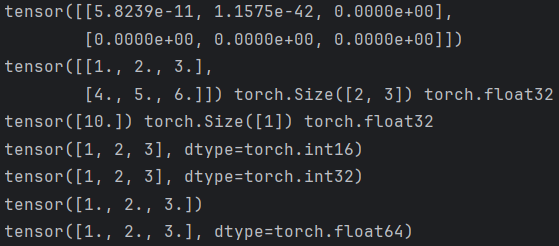
torch.Tensor与torch.tensor区别
| 特性 | torch.Tensor() |
torch.tensor() |
|---|---|---|
| 数据类型推断 | 强制转为 torch.float32 |
根据输入数据自动推断(如整数→int64) |
显式指定 dtype |
不支持 | 支持(如 dtype=torch.float64) |
| 设备指定 | 不支持 | 支持(如 device='cuda') |
| 输入为张量时的行为 | 创建新副本(不继承原属性) | 默认共享数据(除非 copy=True) |
| 推荐使用场景 | 需要快速创建浮点张量 | 需要精确控制数据类型或设备 |
torch.IntTensor
用于创建指定类型的张量,还有诸如Torch.FloatTensor、 torch.DoubleTensor、 torch.LongTensor......等。
如果数据类型不匹配,那么在创建的过程中会进行类型转换,要尽可能避免,防止数据丢失。
python
import torch
def test3():
# 创建指定形状的张量
t1 = torch.IntTensor(2, 3)
print(t1)
t2 = torch.FloatTensor(3, 3)
print(t2, t2.dtype)
t3 = torch.DoubleTensor(3, 3)
print(t3, t3.dtype)
t4 = torch.LongTensor(3, 3)
print(t4, t4.dtype)
t5 = torch.ShortTensor(3, 3)
print(t5, t5.dtype)
if __name__ == "__main__":
test3()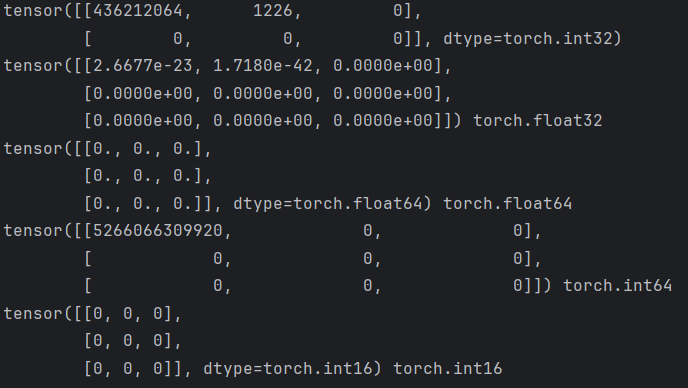
线性张量
使用torch.arange 和 torch.linspace 创建线性张量:
python
import torch
import numpy as np
# 不用科学计数法打印
torch.set_printoptions(sci_mode=False)
def test4():
# 1.创建线性张量
r1 = torch.arange(0, 10, 2)
print(r1)
# 2.在指定空间按照元素个数生成张量:等差
r2 = torch.linspace(3, 10, 10) # star end step
print(r2)
r2 = torch.linspace(3, 10000000, 10)
print(r2)
if __name__ == "__main__":
test4()
随机张量
使用torch.randn 创建随机张量。 使用随机数种子。
随机数种子
python
import torch
def test1():
# 设置随机数种子
torch.manual_seed(123)
# 获取随机数种子
print(torch.initial_seed())
if __name__ == "__main__":
test1()随机张量
在 PyTorch 中,种子影响所有与随机性相关的操作,包括张量的随机初始化、数据的随机打乱、模型的参数初始化等。通过设置随机数种子,可以做到模型训练和实验结果在不同的运行中进行复现。
python
import torch
def test001():
# 1.设置随机数种子
torch.manual_seed(123)
# 2.获取随机数种子,需要查看种子时调用
print(torch.initial_seed())
# 3.生成随机张量,均匀分布(范围 [0, 1))
# 创建2个样本,每个样本3个特征
print(torch.rand(2, 3))
# 4.生成随机张量:标准正态分布(均值 0,标准差 1)
print(torch.randn(2, 3))
# 5.原生服从正态分布:均值为2, 方差为3,形状为1*4的正态分布
print(torch.normal(mean=2, std=3, size=(1, 4)))
if __name__ == "__main__":
test001()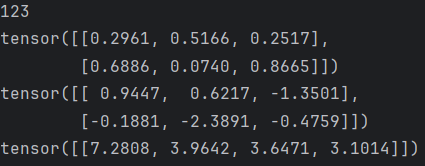
三、Tensor常见属性
获取属性
python
import torch
def test1():
data = torch.tensor([1, 2, 3])
# 张量的数据类型、所在设备、形状
print(data.dtype, data.device, data.shape)
if __name__ == "__main__":
test1()
切换设备
python
import torch
def test001():
data = torch.tensor([1, 2, 3])
print(data.dtype, data.device, data.shape)
# 把数据切换到GPU进行运算
device = "cuda" if torch.cuda.is_available() else "cpu"
data = data.to(device)
print(data.device)
if __name__ == "__main__":
test001()
类型转换
python
import torch
def test001():
data = torch.tensor([1, 2, 3])
print(data.dtype) # torch.int64
# 1. 使用type进行类型转换
data = data.type(torch.float32)
print(data.dtype) # float32
data = data.type(torch.float16)
print(data.dtype) # float16
# 2. 使用类型方法
data = data.float()
print(data.dtype) # float32
# 16 位浮点数,torch.float16,即半精度
data = data.half()
print(data.dtype) # float16
data = data.double()
print(data.dtype) # float64
data = data.long()
print(data.dtype) # int64
data = data.int()
print(data.dtype) # int32
# 使用dtype属性
data = torch.tensor([1, 2, 3], dtype=torch.half)
print(data.dtype)
if __name__ == "__main__":
test001()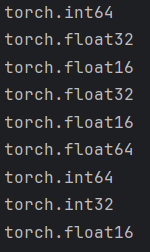
四、Tensor数据转换
共享内存问题:PyTorch与NumPy的转换默认共享内存,修改会影响原始数据
Tensor与Numpy
张量转numpy
python
def test1():
# 张量转numpy 浅拷贝
t_tensor= torch.tensor([1,2,5])
t_numpy= t_tensor.numpy()
t_numpy[0]=2
#深拷贝
t_numpy1=t_tensor.numpy().copy()
print(t_tensor)
print(t_numpy)
print(t_numpy1)
if __name__=='__main__':
test1()
numpy转张量
python
def test3():
#numpy转张量 浅拷贝
t_numpy=np.array([1,2,3])
t_tensor=torch.from_numpy(t_numpy)
print(t_numpy)
print(t_tensor)
#深拷贝
t_numpy=np.array([[1,3,2],[4,6,2]])
t_tensor=torch.tensor(t_numpy)
print(t_numpy)
print(t_tensor)
if __name__=='__main__':
test3()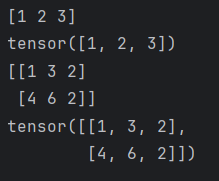
五、Tensor常见操作
获取元素值
python
def test1():
t = torch.tensor(10)
print(t.item())
t2=torch.tensor([[10]])
print(t2.item())
if __name__=='__main__':
test1()阿达玛积
python
import torch
# 点积:对应位置相乘但是不相加
def test1():
data1 = torch.tensor([[1, 2, 3], [4, 5, 6]])
data2 = torch.tensor([[2, 3, 4], [2, 2, 3]])
print(data1 * data2)
def test2():
data1 = torch.tensor([[1, 2, 3], [4, 5, 6]])
data2 = torch.tensor([[2, 3, 4], [2, 2, 3]])
print(data1.mul(data2))
if __name__ == "__main__":
test1()
test2()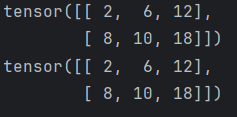
Tensor相乘
python
import torch
def test6():
data1 = torch.tensor([
[1, 2, 3],
[4, 5, 6]
])
data2 = torch.tensor([
[3, 2],
[2, 3],
[5, 3]
])
print(data1 @ data2)
print(data1.matmul(data2))
if __name__ == "__main__":
test6()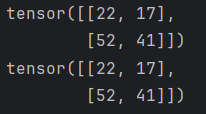
形状操作
reshape
python
import torch
def test001():
#0-10随机生成4行3列数据
data = torch.randint(0, 10, (4, 3))
print(data)
# 1. 使用reshape改变形状
# 包含 2 个块,每个块包含 2 行,每行包含 3 个元素
data = data.reshape(2, 2, 3)
print(data)
# 2. 使用-1表示自动计算
data = data.reshape(2, -1)
print(data)
if __name__ == "__main__":
test001()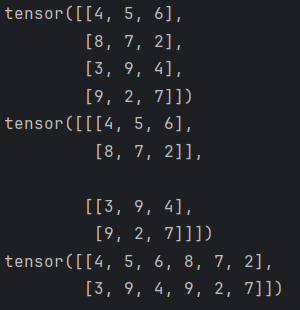
view
view进行形状变换的特征:
-
张量在内存中是连续的;
-
返回的是原始张量视图,不重新分配内存,效率更高;
-
如果张量在内存中不连续,view 将无法执行,并抛出错误。
与reshape比较:
view:高效,但需要张量在内存中是连续的;
reshape:更灵活,但涉及内存复制;
内存连续性
张量的内存布局决定了其元素在内存中的存储顺序。对于多维张量,内存布局通常按照最后一个维度优先 的顺序存储,即先存列,后存行。例如,对于一个二维张量 A,其形状为 (m, n),其内存布局是先存储第 0 行的所有列元素,然后是第 1 行的所有列元素,依此类推。
如果张量的内存布局与形状完全匹配,并且没有被某些操作(如转置、索引等)打乱,那么这个张量就是连续的。
PyTorch 的大多数操作都是基于 C 顺序的,我们在进行变形或转置操作时,很容易造成内存的不连续性。
python
import torch
def test1():
tensor = torch.tensor([[1, 2, 3], [4, 5, 6]])
print("正常情况下的张量:", tensor.is_contiguous())
# 对张量进行转置操作
tensor = tensor.t()
print("转置操作的张量:", tensor.is_contiguous())
print(tensor)
# 此时使用view进行变形操作
# view要求张量连续
tensor = tensor.view(2, -1)
print(tensor)
if __name__ == "__main__":
test1()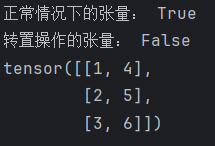
view变形操作
python
import torch
def test2():
tensor = torch.tensor([[1, 2, 3], [4, 5, 6]])
# 将 2x3 的张量转换为 3x2
reshaped_tensor = tensor.view(3, 2)
print(reshaped_tensor)
# 自动推断一个维度,每个维度两个数据
reshaped_tensor = tensor.view(-1, 2)
print(reshaped_tensor)
if __name__ == "__main__":
test2()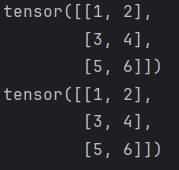
transpose
transpose 用于交换张量的两个维度,注意,是2个维度,它返回的是原张量的视图。
python
import torch
def test3():
data = torch.randint(0, 10, (3, 4, 5))
print(data, data.shape)
# 使用transpose进行形状变换,原始数据的0维度和1维度
transpose_data = torch.transpose(data,0,1)
# transpose_data = data.transpose(0, 1)
print(transpose_data, transpose_data.shape)
if __name__ == "__main__":
test3()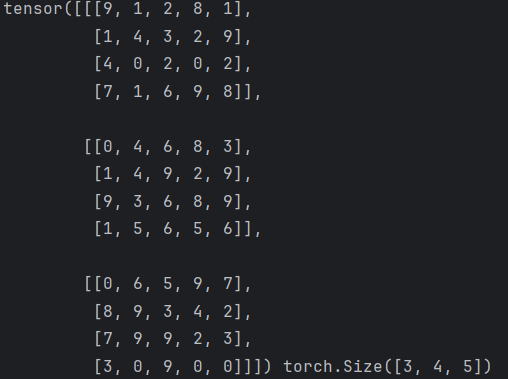
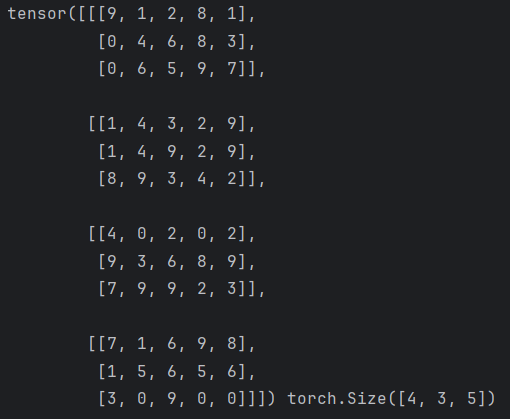
permute
通过重新排列张量的维度来返回一个新的张量,不改变张量的数据,只改变维度的顺序。
python
import torch
def test4():
data = torch.randint(0, 10, (3, 4, 5))
print(data, data.shape)
# 使用permute进行多维度形状变换
permute_data = data.permute(1, 2, 0)
print(permute_data, permute_data.shape)
if __name__ == "__main__":
test4()和 transpose 一样,permute 返回新张量,原张量不变。
变维
unsqueeze:用于在指定位置插入一个大小为 1 的新维度。
squeeze:用于移除所有大小为 1 的维度,或者移除指定维度的大小为 1 的维度。
降维
python
import torch
def test006():
data = torch.randint(0, 10, (1, 4, 5, 1))
print(data, data.shape)
# 进行降维操作
data1 = data.squeeze(0).squeeze(-1)
print(data.shape)
# 移除所有大小为 1 的维度
data2 = torch.squeeze(data)
# 尝试移除第 1 维(大小为 3,不为 1,不会报错,张量保持不变。)
data3 = torch.squeeze(data, dim=1)
print("尝试移除第 1 维后的形状:", data3.shape)
if __name__ == "__main__":
test006()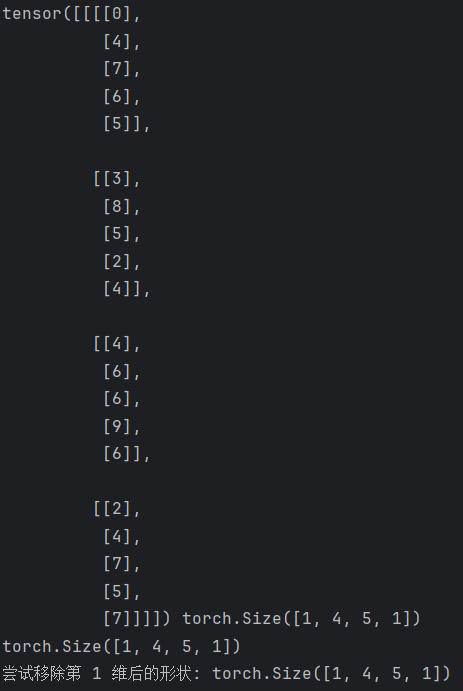
升维
python
import torch
def test7():
data = torch.randint(0, 10, (32, 32, 3))
print(data.shape)
# 升维操作
data = data.unsqueeze(0)
print(data.shape)
if __name__ == "__main__":
test7()
广播机制
广播机制允许在对不同形状的张量进行计算,而无需显式地调整它们的形状。广播机制通过自动扩展较小维度的张量,使其与较大维度的张量兼容,从而实现按元素计算。
广播机制需要遵循以下规则:
-
每个张量的维度至少为1
-
满足右对齐
python
import torch
def test6():
data1d = torch.tensor([1, 2, 3])
data2d = torch.tensor([[4], [2], [3]])
print(data1d.shape, data2d.shape)
# 进行计算:会自动进行广播机制
print(data1d + data2d)
if __name__ == "__main__":
test6()
六、自动微分
自动微分模块torch.autograd负责自动计算张量操作的梯度,具有自动求导功能。自动微分模块是构成神经网络训练的必要模块,可以实现网络权重参数的更新,使得反向传播算法的实现变得简单而高效。
计算梯度
在上述代码中,x 和 y 是输入张量,即叶子节点,z 是中间结果,loss 是最终输出。每一步操作都会记录依赖关系:
z = x * y:z 依赖于 x 和 y。
loss = z.sum():loss 依赖于 z。


叶子节点:
在 PyTorch 的自动微分机制中,叶子节点(leaf node) 是计算图中:
-
由用户直接创建的张量,并且它的 requires_grad=True。
-
这些张量是计算图的起始点,通常作为模型参数或输入变量。
特征:
-
没有由其他张量通过操作生成。
-
如果参与了计算,其梯度会存储在 leaf_tensor.grad 中。
-
默认情况下,叶子节点的梯度不会自动清零,需要显式调用 optimizer.zero_grad() 或 x.grad.zero_() 清除。
判断叶子节点
python
x = torch.tensor([1.0, 2.0, 3.0], requires_grad=True) # 叶子节点
y = x ** 2 # 非叶子节点(通过计算生成)
z = y.sum()
print(x.is_leaf) # True
print(y.is_leaf) # False
print(z.is_leaf) # False叶子节点与非叶子节点的区别
| 特性 | 叶子节点 | 非叶子节点 |
|---|---|---|
| 创建方式 | 用户直接创建的张量 | 通过其他张量的运算生成 |
| is_leaf 属性 | True | False |
| 梯度存储 | 梯度存储在 .grad 属性中 | 梯度不会存储在 .grad,只能通过反向传播传递 |
| 是否参与计算图 | 是计算图的起点 | 是计算图的中间或终点 |
| 删除条件 | 默认不会被删除 | 在反向传播后,默认被释放(除非 retain_graph=True) |
特点:
-
返回的张量是一个新的张量,与原始张量共享数据。
-
对 x.detach() 的操作不会影响原始张量的梯度计算。
-
推荐使用 detach(),因为它更安全,且在未来版本的 PyTorch 中可能会取代 data。
反向传播
使用tensor.backward()方法执行反向传播,从而计算张量的梯度。这个过程会自动计算每个张量对损失函数的梯度。例如:调用 loss.backward() 从输出节点 loss 开始,沿着计算图反向传播,计算每个节点的梯度。
梯度
计算得到的梯度通过tensor.grad访问,这些梯度用于优化模型参数,以最小化损失函数。
标量梯度计算
python
import torch
def test001():
x = torch.tensor(10.5, requires_grad=True)
print(x.requires_grad) # True
# 1. 默认y的requires_grad=True
y = x**2 + 2 * x + 3
print(y.requires_grad) # True
# 2. 如果不需要y计算梯度-with进行上下文管理
with torch.no_grad():
y = x**2 + 2 * x + 3
print(y.requires_grad) # False
# 3. 如果不需要y计算梯度-使用装饰器
@torch.no_grad()
def y_fn(x):
return x**2 + 2 * x + 3
y = y_fn(x)
print(y.requires_grad) # False
# 4. 如果不需要y计算梯度-全局设置,需要谨慎
torch.set_grad_enabled(False)
y = x**2 + 2 * x + 3
print(y.requires_grad) # False
if __name__ == "__main__":
test001()
向量梯度计算
python
import torch
def test3():
# 1. 创建张量:必须为浮点类型
x = torch.tensor([1.0, 2.0, 3.0], requires_grad=True)
# 2. 操作张量
y = x ** 2
# 3. 计算梯度,也就是反向传播
y.backward()
# 4. 读取梯度值
print(x.grad)
if __name__ == "__main__":
test3()以上会报错:错误预警:RuntimeError: grad can be implicitly created only for scalar outputs
python
import torch
def test002():
# 1. 创建张量:必须为浮点类型
x = torch.tensor([1.0, 2.0, 3.0], requires_grad=True)
# 2. 操作张量
y = x ** 2
# 3. 损失函数
loss = y.mean()
# 4. 计算梯度,也就是反向传播
loss.backward()
# 5. 读取梯度值
print(x.grad)
if __name__ == "__main__":
test002()多标量梯度计算
由于 y 是一个向量,我们需要提供一个与 y 形状相同的向量作为 backward() 的参数,这个参数通常被称为 梯度张量 (gradient tensor),它表示 y 中每个元素的梯度。
python
import torch
def test3():
# 1. 创建两个标量
x1 = torch.tensor(5.0, requires_grad=True, dtype=torch.float64)
x2 = torch.tensor(3.0, requires_grad=True, dtype=torch.float64)
# 2. 构建运算公式
y = x1 ** 2 + 2 * x2 + 7
# 3. 计算梯度,也就是反向传播
y.backward()
# 4. 读取梯度值
print(x1.grad, x2.grad)
# 输出:
# tensor(10., dtype=torch.float64) tensor(2., dtype=torch.float64)
if __name__ == "__main__":
test3()多向量梯度计算
python
import torch
def test4():
# 创建两个张量,并设置 requires_grad=True
x = torch.tensor([1.0, 2.0, 3.0], requires_grad=True)
y = torch.tensor([4.0, 5.0, 6.0], requires_grad=True)
# 前向传播:计算 z = x * y
z = x * y
# 前向传播:计算 loss = z.sum()
loss = z.sum()
# 查看前向传播的结果
print("z:", z) # 输出: tensor([ 4., 10., 18.], grad_fn=<MulBackward0>)
print("loss:", loss) # 输出: tensor(32., grad_fn=<SumBackward0>)
# 反向传播:计算梯度
loss.backward()
# 查看梯度
print("x.grad:", x.grad) # 输出: tensor([4., 5., 6.])
print("y.grad:", y.grad) # 输出: tensor([1., 2., 3.])
if __name__ == "__main__":
test4()梯度上下文控制
梯度计算的上下文控制和设置对于管理计算图、内存消耗、以及计算效率至关重要。
控制梯度计算
python
import torch
def test1():
x = torch.tensor(10.5, requires_grad=True)
print(x.requires_grad) # True
# 1. 默认y的requires_grad=True
y = x**2 + 2 * x + 3
print(y.requires_grad) # True
# 2. 如果不需要y计算梯度-with进行上下文管理
with torch.no_grad():
y = x**2 + 2 * x + 3
print(y.requires_grad) # False
# 3. 如果不需要y计算梯度-使用装饰器
@torch.no_grad()
def y_fn(x):
return x**2 + 2 * x + 3
y = y_fn(x)
print(y.requires_grad) # False
# 4. 如果不需要y计算梯度-全局设置,需要谨慎
torch.set_grad_enabled(False)
y = x**2 + 2 * x + 3
print(y.requires_grad) # False
if __name__ == "__main__":
test1()累计梯度
默认情况下,当我们重复对一个自变量进行梯度计算时,梯度是累加的
python
import torch
def test2():
# 1. 创建张量:必须为浮点类型
x = torch.tensor([1.0, 2.0, 5.3], requires_grad=True)
# 2. 累计梯度:每次计算都会累计梯度
for i in range(3):
y = x**2 + 2 * x + 7
z = y.mean()
z.backward()
print(x.grad)
if __name__ == "__main__":
test2()梯度清零
python
import torch
def test2():
# 1. 创建张量:必须为浮点类型
x = torch.tensor([1.0, 2.0, 5.3], requires_grad=True)
# 2. 累计梯度:每次计算都会累计梯度
for i in range(3):
y = x**2 + 2 * x + 7
z = y.mean()
# 2.1 反向传播之前先对梯度进行清零
if x.grad is not None:
x.grad.zero_()
z.backward()
print(x.grad)
if __name__ == "__main__":
test2()
# 输出:
# tensor([1.3333, 2.0000, 4.2000])
# tensor([1.3333, 2.0000, 4.2000])
# tensor([1.3333, 2.0000, 4.2000])总结
以上便是此次对于张量的部分总结操作,如若文章有错或是您还有疑问,欢迎在评论区指正提出,我会尽快的帮助解决,感谢您的阅读!